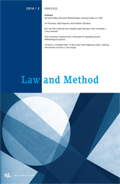|
This article introduces the concepts of play and playfulness within the context of legal-philosophical education. I argue that integrating play and playfulness in legal education engages students and prepares them for dealing with the perpetual uncertainty of late modernity that they will face as future legal professionals. This article therefore aims to outline the first contours of a useful concept of play and playfulness in legal education. Drawing on the work of leading play-theorists Huizinga, Caillois, Lieberman and Csikszentmihalyi, play within legal education can be described as a (1) partly voluntary activity that (2) enables achievement of learning goals, (3) is consciously separate from everyday life by rules and/or make believe, (4) has its own boundaries in time and space, (5) entails possibility, tension and uncertainty and (6) promotes the formation of social grouping. Playfulness is a lighthearted state of mind associated with curiosity, creativity, spontaneity and humor. Being playful also entails being able to cope with uncertainty. The integration of these concepts of play and playfulness in courses on jurisprudence will be illustrated by the detailed description of three play and playful activities integrated in the course ‘Introduction to Legal Philosophy’ at the Vrije Universiteit Amsterdam. |


Law and Method
About this journalSubscribe to the email alerts for this journal here to receive notifications when a new issue is at your disposal.
| Artikel |
|
| Keywords | play, legal education, legal philosophy, student engagement |
| Authors | Hedwig van Rossum |
| AbstractAuthor's information |
| Artikel |
|
| Keywords | literature, teaching tool, student learning, critical movements in law |
| Authors | E. Irem Aki |
| AbstractAuthor's information |
|
Jurisprudence is a domain related to terms such as rules, morality, principles, equality, justice, etc. Legal scholars have to teach the meaning of these terms. However, these are not terms, one can comprehend by just reading their standard definition. These are terms one must digest and learn to use. My argument is that literature or the law and literature movement can be used as a tool in order to explain and discuss these terms. For instance, beyond simply explaining or teaching legal positivism and natural law, Antigone helps students reflect upon the distinction between them. To cite another example, reading Nana can help students think about sex-workers in a way they would never think before. Moreover, the literature can be a useful means in teaching critical movements in law, such as critical legal studies, feminist legal theory and critical race theory. Finally, the terms I stated at the beginning are not only terms of jurisprudence, they are terms we should use properly in order to construct a healthy legal environment. Therefore, to get students comprehend these terms is a crucially important aim. I argue that literature can be a tool in order to achieve this aim. |
| Redactioneel |
|
| Authors | Irene Broekhuijse and Sofia Ranchordás |
| Author's information |

 November
November